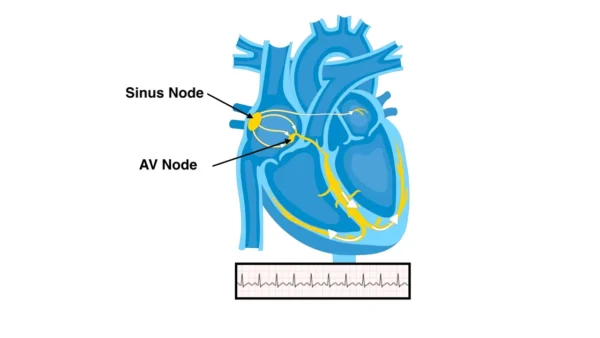An aortic aneurysm is an abnormal enlargement (dilation) of the aorta, the main artery that carries blood from the heart to the rest of the body. Over time, the weakened section of the aortic wall may continue to expand and, if left untreated, can rupture or dissect, leading to life-threatening bleeding.
Aortic aneurysms often develop silently, without symptoms, and are frequently discovered incidentally during imaging studies performed for other reasons. Understanding aneurysm size, location, and growth rate is essential for determining when treatment is needed.
Normal Aortic Size and When It Becomes an Aneurysm
The aorta naturally varies in size depending on age, sex, and body size, but there are accepted reference ranges.
In general:
- Normal ascending aorta: up to ~3.5 cm
- Normal descending thoracic aorta: up to ~3.0 cm
- Normal abdominal aorta: up to ~2.0 cm
An aorta is considered aneurysmal when its diameter increases to 50% or more above normal. In practical terms:
- Abdominal aorta ≥ 3.0 cm
- Thoracic aorta ≥ 4.0 cm
Types of Aortic Aneurysm
Aortic aneurysms are classified based on location, as this strongly influences symptoms, risks, and treatment options.
Thoracic Aortic Aneurysm (TAA)
Thoracic aortic aneurysms occur in the portion of the aorta within the chest.
They may involve:
- The ascending aorta
- The aortic arch
- The descending thoracic aorta
These aneurysms are often associated with hypertension, connective tissue disorders, bicuspid aortic valve, or genetic conditions. Symptoms, when present, may include chest pain, back pain, hoarseness, or shortness of breath.
Abdominal Aortic Aneurysm (AAA)
Abdominal aortic aneurysms develop below the diaphragm, most commonly below the renal arteries.
AAA is more common in older adults, especially men with a history of smoking. Many AAAs remain asymptomatic until they reach a large size or rupture.
Why Aortic Aneurysms Are Dangerous
As an aneurysm enlarges, the aortic wall becomes progressively weaker. The two most serious complications are:
- Aortic rupture, causing massive internal bleeding
- Aortic dissection, in which blood tears through the layers of the aortic wall
The risk of these events rises sharply as aneurysm size increases.
How Aortic Aneurysms Are Diagnosed and Monitored
Aortic aneurysms are diagnosed using imaging studies.
Ultrasound is commonly used to detect and monitor abdominal aortic aneurysms. CT angiography and MRI provide detailed measurements and are essential for thoracic aneurysms and procedural planning.
Once diagnosed, aneurysms are followed with periodic imaging to monitor size and growth rate.
Treatment Options for Aortic Aneurysm
Treatment depends on aneurysm size, growth rate, location, symptoms, and patient-specific risk factors. Not all aneurysms require immediate intervention.
Medical Management and Surveillance
Small aneurysms below treatment thresholds are managed conservatively.
This includes strict blood pressure control, smoking cessation, and regular imaging follow-up. Medications do not shrink aneurysms, but they help slow expansion and reduce rupture risk.
Size Thresholds for Intervention
Intervention is generally recommended when the risk of rupture exceeds the risk of repair.
Common thresholds include:
- Abdominal aortic aneurysm: ≥ 5.5 cm
- Thoracic aortic aneurysm (ascending): ≥ 5.5 cm
- Lower thresholds (≈5.0 cm) in patients with rapid growth, genetic syndromes, or bicuspid aortic valve
Growth rates exceeding 0.5 cm per year are also concerning, even at smaller sizes.
Open Surgical Repair
Open surgical repair involves replacing the weakened aortic segment with a synthetic graft through a traditional surgical approach.
This method provides durable long-term results and is often preferred in younger patients or those with complex anatomy. However, it requires open surgery and longer recovery.
Endovascular Repair
Minimally invasive options have transformed aneurysm treatment.
- EVAR (Endovascular Aneurysm Repair) is used primarily for abdominal aortic aneurysms
- TEVAR (Thoracic Endovascular Aortic Repair) is used for thoracic aneurysms
In these procedures, a stent-graft is delivered through blood vessels (usually from the groin) and deployed inside the aneurysm to reinforce the aorta and redirect blood flow away from the weakened wall.
Endovascular repair typically offers shorter recovery time and lower early procedural risk in appropriately selected patients.
Choosing the Right Treatment Approach
The decision between open surgery and endovascular repair depends on:
- Aneurysm anatomy
- Patient age and overall health
- Surgical risk
- Long-term durability considerations
These decisions are best made in experienced aortic centers using a multidisciplinary approach.
When to Seek Emergency Care
Sudden severe chest, back, or abdominal pain—especially if described as tearing or ripping—requires immediate emergency evaluation, as it may indicate rupture or dissection.
In Summary
An aortic aneurysm is an abnormal enlargement of the aorta that can remain silent but carries a serious risk of rupture as it grows. Normal aortic size, aneurysm diameter, growth rate, and location are key factors guiding management. Treatment ranges from careful surveillance to open surgical repair or minimally invasive procedures such as EVAR and TEVAR. With timely diagnosis and appropriate intervention, outcomes are significantly improved.
Reference: Aortic Aneurysm






